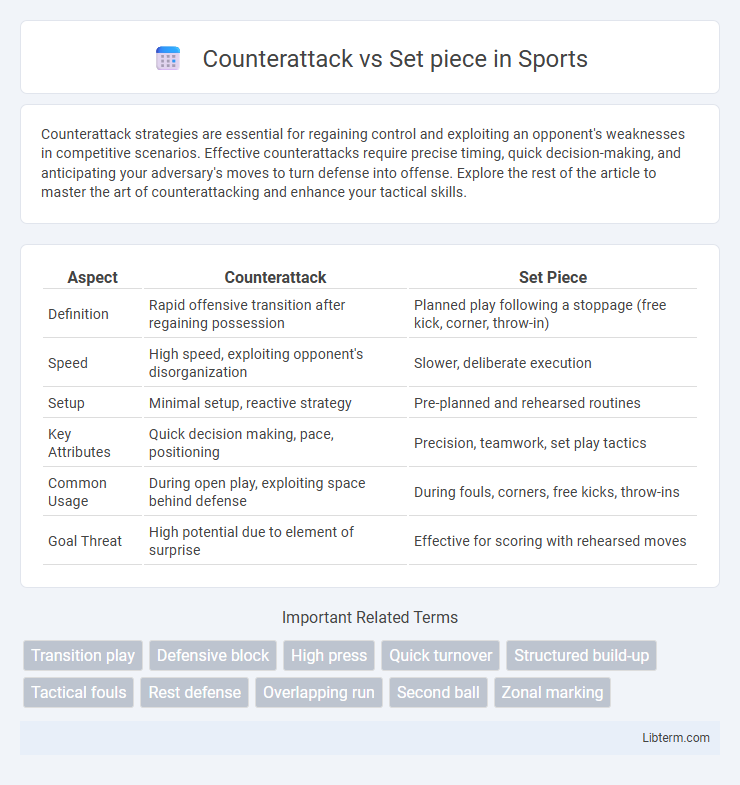Counterattack strategies are essential for regaining control and exploiting an opponent's weaknesses in competitive scenarios. Effective counterattacks require precise timing, quick decision-making, and anticipating your adversary's moves to turn defense into offense. Explore the rest of the article to master the art of counterattacking and enhance your tactical skills.
Table of Comparison
| Aspect | Counterattack | Set Piece |
|---|---|---|
| Definition | Rapid offensive transition after regaining possession | Planned play following a stoppage (free kick, corner, throw-in) |
| Speed | High speed, exploiting opponent's disorganization | Slower, deliberate execution |
| Setup | Minimal setup, reactive strategy | Pre-planned and rehearsed routines |
| Key Attributes | Quick decision making, pace, positioning | Precision, teamwork, set play tactics |
| Common Usage | During open play, exploiting space behind defense | During fouls, corners, free kicks, throw-ins |
| Goal Threat | High potential due to element of surprise | Effective for scoring with rehearsed moves |
Understanding Counterattack: Key Principles
Counterattack is a rapid offensive strategy triggered immediately after regaining possession, exploiting the opponent's disorganized defense to create scoring opportunities. Key principles include quick transitions, high tempo passing, spatial awareness to identify gaps, and coordinated player movement to overload the opposition. Effective counterattacks rely on speed, precision, and timing to capitalize on the opponent's momentary vulnerability before defensive lines are established.
Set Pieces Explained: Types and Importance
Set pieces in football encompass free kicks, corners, and throw-ins, serving as strategic opportunities to score or regain possession. Mastery of set pieces involves precise delivery, positioning, and timing, making them critical for breaking structured defenses. Teams with well-practiced routines often convert a higher percentage of these moments into goals, highlighting their significance in match outcomes.
Tactical Differences: Counterattack vs Set Piece
Counterattacks rely on rapid transitions and exploiting spaces left by opponents after a turnover, emphasizing speed, precision, and player positioning to outpace defenders. Set pieces focus on rehearsed, structured plays that maximize aerial duels, spatial organization, and targeted delivery, often involving coordinated movements and physical matchups. Tactical execution in counterattacks demands real-time decision-making and quick ball progression, while set pieces benefit from pre-planned routines and specific player roles to capitalize on dead-ball situations.
Player Roles in Counterattacks
In counterattacks, player roles are sharply defined to maximize speed and precision, with wingers and forwards exploiting space behind the opposition's defense to initiate rapid attacks. Midfielders focus on quick ball recovery and accurate passing to transition swiftly from defense to offense, while defenders prioritize intercepting opposition plays and launching immediate forward passes. Effective counterattacks rely on players with high acceleration, vision, and decision-making to capitalize on momentary gaps before the opposing team organizes their set piece defense.
Set Piece Specialists: Who Makes the Difference?
Set piece specialists significantly impact football matches by transforming free kicks, corners, and penalties into goal-scoring opportunities. Players like Kevin De Bruyne, Trent Alexander-Arnold, and James Ward-Prowse excel in delivering precise crosses and deadly shots, increasing a team's chance of scoring from set pieces. Their expertise in positioning, technique, and vision often makes the difference in tight games where counterattacks may falter.
Training Drills: Mastering Counterattacks
Training drills for mastering counterattacks emphasize rapid transitions from defense to offense, enhancing players' speed, decision-making, and positional awareness. Exercises include quick passing sequences, sprinting after ball recovery, and situational simulations replicating opponent set pieces to exploit space effectively. Integrating small-sided games with focused counterattack scenarios sharpens team coordination and exploitation of defensive gaps.
Set Piece Strategies: Corner Kicks, Free Kicks, and Beyond
Set piece strategies in football maximize scoring opportunities through well-rehearsed routines during corner kicks and free kicks, utilizing precise delivery, player positioning, and movement patterns. Corner kicks often involve tall, strong headers clustering near the goal, while free kicks may feature direct shots on goal or intricate passing plays to disrupt defensive setups. Effective set piece execution requires detailed analysis of opponent weaknesses, highlighting the importance of rehearsed variations and coordinated team efforts to capitalize on dead-ball situations.
Psychological Impact: Pressure Moments
Counterattacks create high-pressure moments by exploiting defensive vulnerabilities swiftly, forcing opponents into panic and rushed decisions that can lead to critical errors. Set pieces generate intense psychological pressure through structured, rehearsed scenarios where teams anticipate scoring opportunities, elevating stress levels and demanding precise execution. Both tactics leverage pressure to destabilize opponents, but counterattacks rely on speed and unpredictability, while set pieces depend on organization and mental discipline.
Analyzing Famous Counterattack and Set Piece Goals
Famous counterattack goals often showcase rapid transitions and player speed, such as Sergio Ramos' quick break against Barcelona in 2017, exploiting defensive disorganization. Set piece goals like Cristiano Ronaldo's header from a corner for Real Madrid highlight precise positioning and aerial dominance. Analyzing these goals reveals the importance of tactical awareness, timing, and set piece execution in maximizing scoring opportunities.
Choosing the Right Approach: Match Situation Factors
Selecting the ideal tactic between counterattack and set piece depends heavily on the match situation, including the current scoreline, time remaining, and the opposition's defensive organization. Counterattacks thrive when a team faces a high-pressing opponent, capitalizing on quick transitions and exploiting space behind defenders. Set pieces offer critical scoring chances when a team has strong aerial presence or well-rehearsed routines, especially in tightly contested matches where open play opportunities are limited.
Counterattack Infographic

 libterm.com
libterm.com